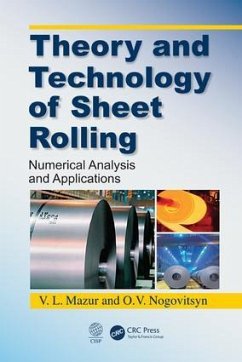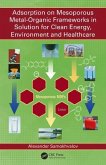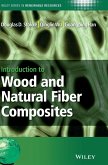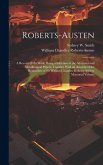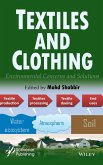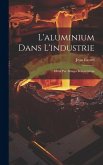- Gebundenes Buch
- Merkliste
- Auf die Merkliste
- Bewerten Bewerten
- Teilen
- Produkt teilen
- Produkterinnerung
- Produkterinnerung
This book details new approaches, computational techniques, and reliable calculation methods of leaf-rolling modes, forecasting and optimization of the technologies, increasing productivity of the mill and a radical improvement in the quality of steel products.
Andere Kunden interessierten sich auch für
![Adsorption on Mesoporous Metal-Organic Frameworks in Solution for Clean Energy, Environment and Healthcare Adsorption on Mesoporous Metal-Organic Frameworks in Solution for Clean Energy, Environment and Healthcare]() Alexander SamokhvalovAdsorption on Mesoporous Metal-Organic Frameworks in Solution for Clean Energy, Environment and Healthcare164,99 €
Alexander SamokhvalovAdsorption on Mesoporous Metal-Organic Frameworks in Solution for Clean Energy, Environment and Healthcare164,99 €![Descriptive Catalogue Of Chemical Apparatus, Chemicals And Pure Reagents Descriptive Catalogue Of Chemical Apparatus, Chemicals And Pure Reagents]() Edward N KentDescriptive Catalogue Of Chemical Apparatus, Chemicals And Pure Reagents47,99 €
Edward N KentDescriptive Catalogue Of Chemical Apparatus, Chemicals And Pure Reagents47,99 €![Wood and Natural Fiber Composi Wood and Natural Fiber Composi]() Douglas D StokkeWood and Natural Fiber Composi89,99 €
Douglas D StokkeWood and Natural Fiber Composi89,99 €![Roberts-Austen Roberts-Austen]() William Chandler Roberts-AustenRoberts-Austen36,99 €
William Chandler Roberts-AustenRoberts-Austen36,99 €![Chemische En Physische Oefeningen Voor De Beminnaars Der Schei- En Natuurkunde In't Algemeen, Ter Bevordering Van Industrie En Oeconomiekunde, En Ten Nutte Der Apothekers, Fabrikanten En Trafikanten In 't Bijzonder, Volume 2... Chemische En Physische Oefeningen Voor De Beminnaars Der Schei- En Natuurkunde In't Algemeen, Ter Bevordering Van Industrie En Oeconomiekunde, En Ten Nutte Der Apothekers, Fabrikanten En Trafikanten In 't Bijzonder, Volume 2...]() Pieter Johannes KasteleynChemische En Physische Oefeningen Voor De Beminnaars Der Schei- En Natuurkunde In't Algemeen, Ter Bevordering Van Industrie En Oeconomiekunde, En Ten Nutte Der Apothekers, Fabrikanten En Trafikanten In 't Bijzonder, Volume 2...37,99 €
Pieter Johannes KasteleynChemische En Physische Oefeningen Voor De Beminnaars Der Schei- En Natuurkunde In't Algemeen, Ter Bevordering Van Industrie En Oeconomiekunde, En Ten Nutte Der Apothekers, Fabrikanten En Trafikanten In 't Bijzonder, Volume 2...37,99 €![Textiles and Clothing Textiles and Clothing]() Textiles and Clothing214,99 €
Textiles and Clothing214,99 €![L'aluminium Dans L'industrie: Métal Pur Alliages D'aluminium L'aluminium Dans L'industrie: Métal Pur Alliages D'aluminium]() Jean EscardL'aluminium Dans L'industrie: Métal Pur Alliages D'aluminium31,99 €
Jean EscardL'aluminium Dans L'industrie: Métal Pur Alliages D'aluminium31,99 €-
-
-
This book details new approaches, computational techniques, and reliable calculation methods of leaf-rolling modes, forecasting and optimization of the technologies, increasing productivity of the mill and a radical improvement in the quality of steel products.
Produktdetails
- Produktdetails
- Verlag: CRC Press
- Seitenzahl: 494
- Erscheinungstermin: 7. November 2018
- Englisch
- Abmessung: 236mm x 155mm x 30mm
- Gewicht: 839g
- ISBN-13: 9780815387060
- ISBN-10: 0815387067
- Artikelnr.: 51796815
- Herstellerkennzeichnung
- Libri GmbH
- Europaallee 1
- 36244 Bad Hersfeld
- gpsr@libri.de
- Verlag: CRC Press
- Seitenzahl: 494
- Erscheinungstermin: 7. November 2018
- Englisch
- Abmessung: 236mm x 155mm x 30mm
- Gewicht: 839g
- ISBN-13: 9780815387060
- ISBN-10: 0815387067
- Artikelnr.: 51796815
- Herstellerkennzeichnung
- Libri GmbH
- Europaallee 1
- 36244 Bad Hersfeld
- gpsr@libri.de
Valery Mazur is a doctor of technical sciences, professor, and corresponding member of the National Academy of Sciences of Ukraine. He works as a Chief Scientific worker of Physical and Technological Institute of Metals and Alloys of National Academy of Sciences of Ukraine where the main direction of scientific activity is the development of the theory of rolling on the basis of modern computing capabilities, development and implementation of energy saving technologies in metallurgy, increasing efficiency and improving the quality of flat-rolled products. He has published more than 350 scientific articles, 20 monographs, over 150 patents for inventions. The most famous book, "Surface Sheet" (1975), "Production of automobile sheet" (1979), "Production of high-quality sheet " (1982), "The theory of rolling (hydrodynamic lubrication effects)" (1989),"Quality Control sheet rent" (1997). Alexey Nogovitsyn is a doctor of technical sciences, professor. He works as the head of the department for continuous casting and foundry processes and deformation of Physical and Technological Institute of Metals and Alloys, National Academy of Sciences of Ukraine. He is the author of two monographs and more than 100 scientific papers, 20 inventor's certificates. The main direction of his scientific activity is the development of theory and improving the technology of continuous rolling of sheet metal, rolling mills increased productivity, improved quality of hot-rolled and cold-rolled sheet products.
Introduction
1. One-dimensional model of the deformation zone
2. Mathematical model of wide-strip hot rolling of steel
3. Control of the formation of the microstructure and mechanical properties
of rolled steel
4. Stability and reliability of the hot rolling process
5. Asymmetric strip rolling
6. Mathematical model of the process of cold rolling of strips in
continuous mills
7. Optimisation of the technological conditions of continuous cold rolling
of strips
8. Stability of the technology of cold rolling of strips
9. Features of the rolling method of production of sheet steel
11. Energy saving when rolling strips
12. Preventing defects in thin sheet steel
References
Index
1. One-dimensional model of the deformation zone
2. Mathematical model of wide-strip hot rolling of steel
3. Control of the formation of the microstructure and mechanical properties
of rolled steel
4. Stability and reliability of the hot rolling process
5. Asymmetric strip rolling
6. Mathematical model of the process of cold rolling of strips in
continuous mills
7. Optimisation of the technological conditions of continuous cold rolling
of strips
8. Stability of the technology of cold rolling of strips
9. Features of the rolling method of production of sheet steel
11. Energy saving when rolling strips
12. Preventing defects in thin sheet steel
References
Index
Introduction
1. One-dimensional model of the deformation zone
2. Mathematical model of wide-strip hot rolling of steel
3. Control of the formation of the microstructure and mechanical properties
of rolled steel
4. Stability and reliability of the hot rolling process
5. Asymmetric strip rolling
6. Mathematical model of the process of cold rolling of strips in
continuous mills
7. Optimisation of the technological conditions of continuous cold rolling
of strips
8. Stability of the technology of cold rolling of strips
9. Features of the rolling method of production of sheet steel
11. Energy saving when rolling strips
12. Preventing defects in thin sheet steel
References
Index
1. One-dimensional model of the deformation zone
2. Mathematical model of wide-strip hot rolling of steel
3. Control of the formation of the microstructure and mechanical properties
of rolled steel
4. Stability and reliability of the hot rolling process
5. Asymmetric strip rolling
6. Mathematical model of the process of cold rolling of strips in
continuous mills
7. Optimisation of the technological conditions of continuous cold rolling
of strips
8. Stability of the technology of cold rolling of strips
9. Features of the rolling method of production of sheet steel
11. Energy saving when rolling strips
12. Preventing defects in thin sheet steel
References
Index

